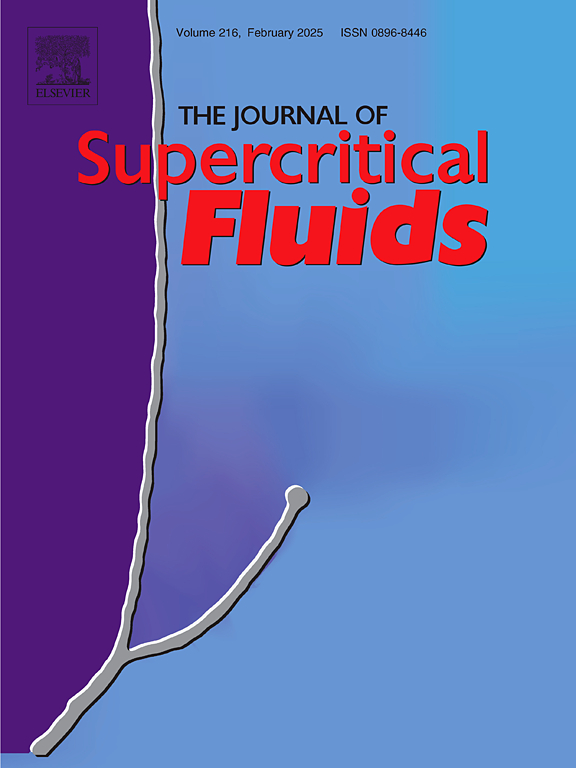不同CO2浓度连续两步萃取分离万寿菊花的亲脂性化合物
IF 4.4
3区 工程技术
Q2 CHEMISTRY, PHYSICAL
引用次数: 0
摘要
蒸馏法已被广泛地应用于田七(Tagetes patula L.)精油的回收,而用二氧化碳对这种植物进行分馏超临界流体萃取(SFE-CO2)的研究仍显不足,有关 CO2 萃取物中挥发性物质和植物化学物质的数据也未见报道。本研究调查了使用超临界二氧化碳对 T. patula 花进行分馏的情况,初始萃取压力较低(10 兆帕、40°C;SFE-CO2-I),随后在较高压力下进一步萃取(45 兆帕、50°C;SFE-CO2-II)。通过水力蒸馏获得的精油含有最多的挥发性物质,其次是 SFE-CO2-I,而 SFE-CO2-II 的挥发性较差。与低压相比,高压提取的植物甾醇、生育酚和不饱和脂肪酸的含量要少 1.25-2.9 倍,但对植物色素(叶绿素、类胡萝卜素)的提取更有效。结果表明,在不同的压力下,可以选择性地浓缩斑鸠菊花中的不同亲脂性化合物类别,凸显了 SFE-CO2 分馏的潜力。本文章由计算机程序翻译,如有差异,请以英文原文为准。
Fractionation of lipophilic compounds of Tagetes patula flowers by using consecutive 2-step extraction with different CO2 densities
Distillation has been widely applied for the recovery of Tagetes patula L. essential oil, while fractional supercritical fluid extraction of this plant with carbon dioxide (SFE-CO2) remains underexplored and data on the volatiles and phytochemicals in CO2 extracts have not been reported. This study investigated the fractionation of T. patula flowers using supercritical CO2, with initial extraction at lower pressure (10 MPa, 40°C; SFE-CO2-I) followed by further extraction at higher pressure (45 MPa, 50°C; SFE-CO2-II). Essential oil obtained by hydro-distillation contained the most volatiles, followed by SFE-CO2-I, while SFE-CO2-II was a poor volatile source. Higher pressure yielded 1.25–2.9 times less phytosterols, tocopherols, and unsaturated fatty acids compared to lower pressure, but was more effective for plant pigment (chlorophylls, carotenoids) extraction. The results demonstrate that different lipophilic compound classes in T. patula flowers can be selectively concentrated at varying pressures, highlighting the potential of SFE-CO2 fractionation.
求助全文
通过发布文献求助,成功后即可免费获取论文全文。
去求助
来源期刊

Journal of Supercritical Fluids
工程技术-工程:化工
CiteScore
7.60
自引率
10.30%
发文量
236
审稿时长
56 days
期刊介绍:
The Journal of Supercritical Fluids is an international journal devoted to the fundamental and applied aspects of supercritical fluids and processes. Its aim is to provide a focused platform for academic and industrial researchers to report their findings and to have ready access to the advances in this rapidly growing field. Its coverage is multidisciplinary and includes both basic and applied topics.
Thermodynamics and phase equilibria, reaction kinetics and rate processes, thermal and transport properties, and all topics related to processing such as separations (extraction, fractionation, purification, chromatography) nucleation and impregnation are within the scope. Accounts of specific engineering applications such as those encountered in food, fuel, natural products, minerals, pharmaceuticals and polymer industries are included. Topics related to high pressure equipment design, analytical techniques, sensors, and process control methodologies are also within the scope of the journal.
 求助内容:
求助内容: 应助结果提醒方式:
应助结果提醒方式:


